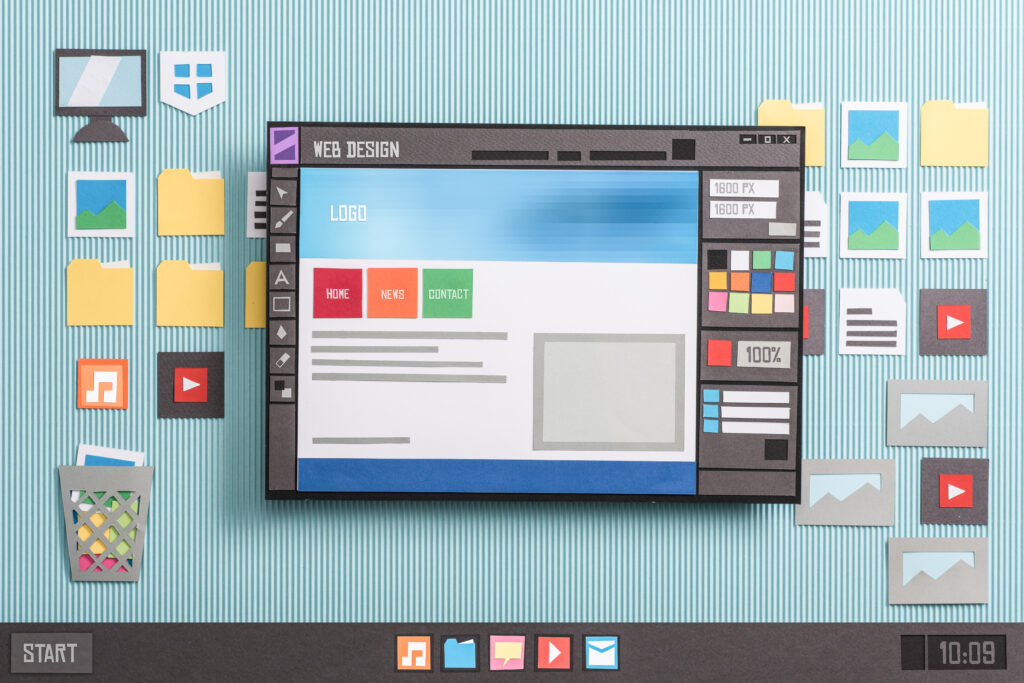
The design of your website plays a crucial role in determining whether visitors convert into customers, leads, or subscribers. However, many websites struggle with poor design choices that can drastically impact their conversion rates. A website that doesn’t meet user expectations, or worse, frustrates them, can lead to abandoned shopping carts, high bounce rates, and lost opportunities.
The good news is that most of these issues are fixable. By identifying and rectifying common website conversion impact you can turn your website into a high-converting powerhouse. In this blog, we will cover several critical design errors that may be hurting your business and provide actionable solutions to fix them.
1. Slow Loading Times
One of the most common and damaging mistakes that create website conversion impact is slow loading speeds. Research indicates that users expect websites to load within two seconds, and any delay beyond that can result in a high bounce rate. In fact, every second a page takes to load can reduce conversions by 7%. In a world where patience is scarce, slow loading speeds can cost you valuable sales.
How to Fix It:
- Optimise Image Sizes: Images that aren’t optimised for the web can slow down page loading times. Use formats like JPEG for photos and PNG for graphics with fewer colours. Additionally, you can reduce file sizes using compression tools like TinyPNG or ImageOptim.
- Minimise HTTP Requests: Each element on a webpage (e.g., images, scripts, CSS files) sends a request to the server. Reducing these requests can significantly speed up your site. Tools like Google PageSpeed Insights can help identify unnecessary elements that are slowing your page down.
- Use Content Delivery Networks (CDNs): CDNs distribute your website’s content across multiple servers worldwide, reducing the load time by serving content from the server closest to the user’s location. Popular CDNs include Cloudflare and Amazon CloudFront.
- Implement Lazy Loading: This technique only loads content when it’s visible on the user’s screen, reducing the initial page load time. Tools like LazyLoad can help implement this feature.
For more advanced insights into speeding up your site, check out these conversion rate optimisation tips.
2. Poor Mobile Responsiveness
With mobile usage now surpassing desktop usage for browsing and shopping, mobile responsiveness is no longer a “nice-to-have” feature – it’s a necessity. A website that’s not optimised for mobile can lead to a frustrating experience for users, which directly creates website conversion impact. Research suggests that over 60% of users will abandon a site if it isn’t mobile-friendly.
How to Fix It:
- Responsive Design: Ensure your website uses responsive web design, meaning it automatically adjusts its layout to fit the device it’s being viewed on. This provides an optimal viewing experience for all screen sizes. You can learn more about responsive design on Smashing Magazine.
- Test Your Site on Multiple Devices: Regularly test your website on different devices (smartphones, tablets, desktops) to ensure it renders properly across all platforms. Tools like BrowserStack allow you to test how your site looks on different devices and browsers.
- Mobile-First Design: When redesigning your site, consider a mobile-first approach. This prioritises the mobile version of your site before scaling it up for larger devices. Mobile-first design is proven to enhance user experience and boost conversions. Google’s mobile-first indexing guide provides a helpful overview.
A mobile-friendly site ensures that your visitors have a seamless experience, regardless of the device they are using, which directly impacts your conversion rate optimisation efforts.
3. Complicated Navigation
Navigation plays a pivotal role in your website conversion impact. If your visitors can’t easily find what they’re looking for, they’ll likely abandon your site and look elsewhere. According to a study by HubSpot, 76% of users say the most important factor in a website’s design is ease of navigation.
How to Fix It:
- Simplify Menus: Organise your content into clear categories and avoid overwhelming users with too many options. Stick to essential menu items and consider grouping related items together for easy access.
- Include a Search Function: A search bar at the top of your page allows visitors to quickly find what they need, improving their overall experience and making them more likely to convert. For more on website search design, check out this UX Design article.
- Sticky Navigation Bars: If your pages are long, include a sticky navigation bar that remains visible as users scroll. This ensures that your menu is always accessible, making it easier for visitors to navigate your site.
A simplified, intuitive navigation system helps reduce bounce rates and ensures that visitors can easily find what they need, improving the chances of conversion and decreases negative website conversion impact.
4. Lack of Clear Calls-to-Action (CTAs)
Clear and compelling calls to action (CTAs) are critical in guiding users toward conversion. Without a clear CTA, visitors may not know what action to take next. Whether you want users to sign up for a newsletter, make a purchase, or contact your team, you need to make it obvious.
How to Fix It:
- Use Action-Oriented Language: Your CTA should inspire action. Words like “Get Started,” “Buy Now,” or “Claim Your Offer” work well because they clearly tell users what to do.
- Make CTAs Stand Out: Your CTAs should stand out visually from the rest of the page. Use contrasting colours, bold text, and larger buttons to make them impossible to miss. You can find more tips on designing effective CTAs in this Nielsen Norman Group article.
- Strategic Placement: Place CTAs in prominent locations such as at the top of the page, within the content, and at the end of the page. This ensures users can take action at any point during their visit.
Strategically placed CTAs guide visitors through the conversion process, increasing the likelihood of them completing an action.
5. Poor Visual Hierarchy
A confusing or cluttered layout can overwhelm users and lead them to leave your site before they convert. Effective visual hierarchy guides the user’s eye to the most important elements of your page, such as CTAs, product images, and key messages. This is a massive website conversion impact.
How to Fix It:
- Use Contrasting Colours: Contrast between elements helps guide the user’s attention. Ensure key elements like CTAs are in colours that contrast with the background and surrounding elements.
- Prioritise Key Information: Place the most important information, like your value proposition, at the top of the page, and use headings and subheadings to break up text. For more on organising web content, see this Smashing Magazine article.
- Whitespace: Use plenty of whitespace to make the content more digestible. Crowded pages can overwhelm users and lead them to abandon your site.
By using visual hierarchy effectively, you help users focus on what matters most, improving the chances of conversion.
6. Poor or Outdated Content
Content is a vital part of your website’s success, but poor-quality or outdated content can deter potential customers. Users are looking for relevant, valuable information, and if they can’t find it on your site, they’re likely to leave and look elsewhere. This is a website conversion impact.
How to Fix It:
- Update Content Regularly: Outdated content, such as old blog posts, pricing information, or outdated product offerings, can frustrate visitors. Regularly update your content to reflect current trends and accurate details. Tools like BuzzSumo can help identify trending topics that resonate with your audience.
- Invest in Quality Content: High-quality, well-written content that addresses your audience’s needs is essential. If your content is engaging and informative, users are more likely to stay on your site longer and convert.
- SEO Optimisation: Optimise your content for search engines to increase its visibility. Well-optimised content can attract more visitors, resulting in higher conversion rates. Check out Moz’s beginner’s guide to SEO for a great starting point.
Fresh and relevant content keeps visitors engaged and encourages them to take action on your site.
7. Not Using Trust Signals
Trust is a major factor in converting website visitors. If visitors don’t feel that your site is secure or trustworthy, they won’t make a purchase or provide personal information. Trust signals such as customer reviews, security badges, and testimonials can help build confidence in your brand.
How to Fix It:
- Show Customer Reviews: Display positive testimonials and reviews prominently on your site. Social proof, such as product ratings, is an effective way to establish credibility. You can use platforms like Trustpilot to collect and display customer feedback.
- Use SSL Certificates: SSL certificates ensure that your website is secure for transactions. Display a security badge to reassure customers that their data is safe. Learn more about SSL certificates at Let’s Encrypt.
- Trust Badges and Affiliations: Display logos of trusted brands, payment processors, or industry affiliations to boost credibility. Tools like BadgeCert can help you display verified badges.
Incorporating trust signals throughout your site helps visitors feel confident in making a purchase or taking any other action.
Conclusion
In today’s digital landscape, website conversion impacts can seriously harm your business’s ability to grow. By addressing the issues outlined in this article – from slow loading times to poor mobile responsiveness and ineffective CTAs – you can dramatically improve your website’s user experience and boost conversions.
Remember, a successful website isn’t just about aesthetics – it’s about creating a seamless experience that encourages users to take action. Start implementing these fixes today, and watch your conversion rates rise!
For more resources on conversion rate optimisation, as well as commercial training and management training, feel free to explore our additional materials.









